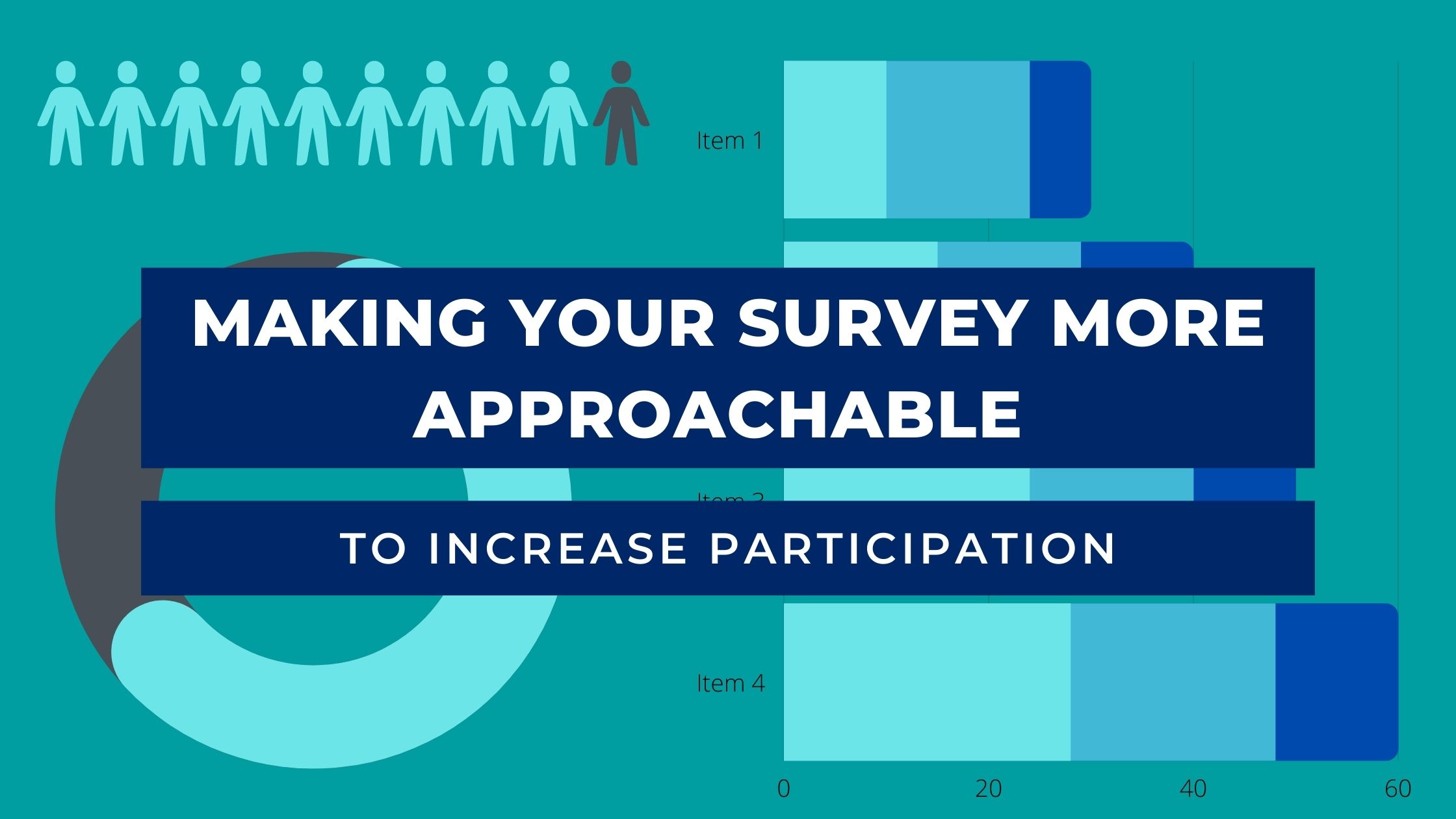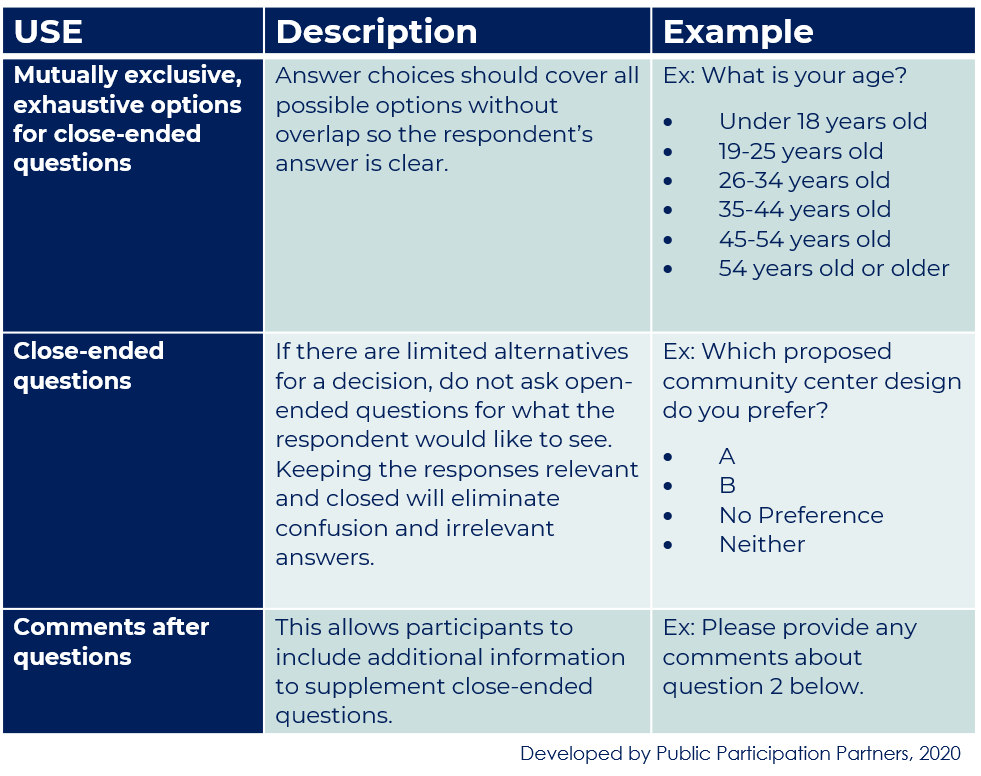
25 Aug Making Your Survey More Approachable to Increase Participation
Surveys are a great way for gathering feedback from community members to help influence decision-making. With surveys, you can ask specific, relevant questions that ensure that you are collecting input that can be used in your project. However, it is crucial that surveys are planned and designed effectively to ensure that all that wish to share their opinion are able to do so easily.
From the perspective of community members, taking surveys can feel daunting with the technical jargon, excessive amounts of questions, or a lack of understanding of how their feedback impacts the project. For these reasons and more, community members may choose not to participate in the survey, thus providing less data and making your survey less effective.
Ensuring that your survey is approachable will entice more community members to participate, which will gather more representative data to help with decision-making. Here are some tips for making your survey more approachable:
Clearly state what the survey is about and what data will be used for.
First and foremost, it’s crucial that you communicate with community members about the purpose and topics of the survey and how the data collected from their participation will be used. This should be included in your survey prior to any questions. Not only does this make your survey more ethical, but it also clearly describes the survey and provides the participant with relevant information to help them decide if they want to participate.
Keep questions concise and relevant.
Surveys are a great way to collect specific feedback about particular topics within a project. For example, if your agency is working on a small area plan, one survey may focus specifically on what mobility and connectivity improvements are preferred for the area. If you have multiple broad topics that you are looking for feedback on, it may be best to conduct multiple surveys or focus on gathering feedback through additional data collection methods.
As your survey is most likely focused on one particular project topic, keep the questions in the survey relevant. Don’t ask questions about additional topics, as this will add extra length to your survey and be outside of the purpose of the survey.
Use plain language free from jargon.
Jargon and complex terms can deter community members from participating in your survey as they may not understand the concepts or questions being asked. Keep language as simple as possible and when necessary to use complex terminology, provide definitions of the terms.
Visuals are another great way to make your survey wording more approachable; use images to visually represent concepts and designs to make the survey more understandable for the participant.
Use closed ended questions when possible and ensure that answer options are mutually exclusive and exhaustive.
Open ended questions allow for participants to share more personalized feedback as they complete the survey, but it can also be more time consuming. Closed ended questions require less time, and gather data that is easier to understand, especially when surveying about preferences or attitudes where there are predetermined options to choose from. To accommodate participants that wish to leave additional comments and information, include an optional comment section after closed ended questions.

It is also important to remember that answer choices are mutually exclusive and exhaustive when writing closed ended questions. If a respondent is not sure which answer to pick as it falls under multiple categories, or their answer choice is not an option at all, then they will feel less inclined to participate. Ensuring that answer choices are mutually exclusive and exhaustive makes participation easier for the participants.
Respect privacy and voluntary participation of the participant.
Some community members may want to participate in a survey, but may be worried about sharing their feedback if it can be traced back to them. This is why it’s crucial to ensure anonymity for participants. Many will feel more inclined to participate when they know that their responses will remain confidential.
Further, allow for voluntary participation for respondents. While as an agency you want to collect as much data as possible, it is also crucial to allow for respondents to skip questions they do not wish to answer while still being able to participate in the overall survey. Voluntary participation is especially necessary with demographic questions, as participants should not be required to share identifying information about themselves if they do not wish to.
Keep the survey as brief as possible.
The easiest way to make your survey more approachable is to keep it short and to the point. Overly long surveys require an unreasonable time commitment from participants, making it less likely that they will participate or that they will complete the survey. It is best to determine which questions are the most important to ask and keep the survey brief to respect participants’ time and encourage them to complete the survey.
Tip: it is helpful to include how long the survey is estimated to take to complete in the description at the beginning of the survey! This will allow participants to prepare and ensure that they have enough time to fully participate.
It’s important to keep approachability in mind when creating a survey to ensure that all who wish to participate are able to easily. This will allow you to gather more feedback to make more representative decisions for the community.
About the Author: Katie Maynard started her journey with Public Participation Partners as a Community Engagement Assistant in January 2020 and became a Communications and Engagement Specialist in June 2021. When not assisting with public involvement, Katie enjoys reading, traveling to the beach, and spending time with her pets.


Sorry, the comment form is closed at this time.